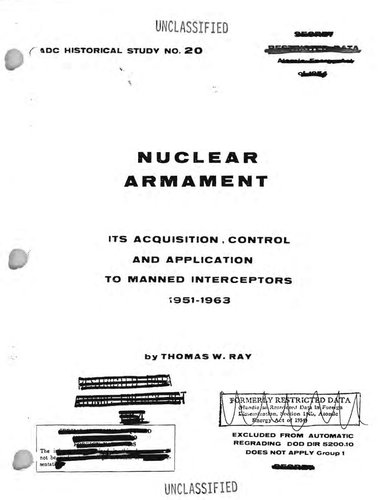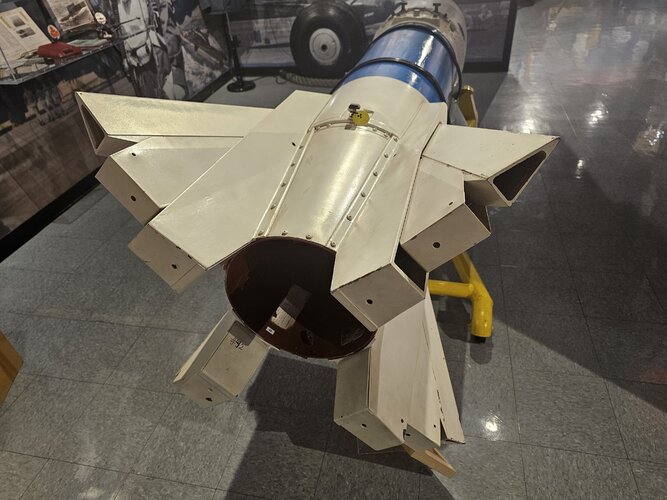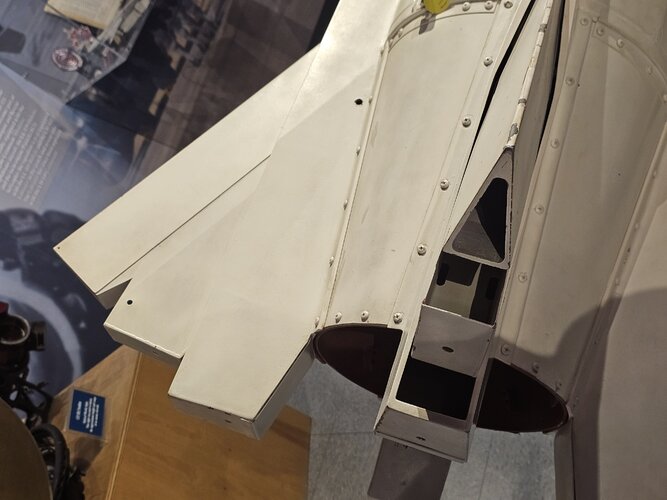You are using an out of date browser. It may not display this or other websites correctly.
You should upgrade or use an alternative browser.
You should upgrade or use an alternative browser.
Air-to-Air nuclear weapons
- Thread starter AN/AWW-14(V)
- Start date
Ravinoff
Hoodoo Operator
- Joined
- 5 October 2017
- Messages
- 124
- Reaction score
- 289
Ah, early Cold War insanity at its finest. Glancing through this, it might help a few people to clarify that the weapon designations used in this are (of course, since it's 1951-1963) prior to the 1963 Tri-Service Missile And Drone designation system. BOMARCs are BOMARCs, but the GAR-11 is better known as the Hughes AIM-26 Falcon (which in a rather roundabout way is the great-granddaddy of the AIM-54 Phoenix) and the MB-1 is AIR-2 Genie. And it's a fun side note that during the live test of the latter during Operation Plumbbob, several Air Force officers were standing directly under the detonation point to show how safe it was.
The whole thought process leading up to the AIR-2 is in itself pretty funny to look back at, too. By the late '40s, the USAF is realizing its Browning AN/M3 .50s are getting to be obsolete, so they start moving towards 20mm cannons. But damn, those aren't performing great either, not enough ammo or time on target. So alright...rockets. The F-86D gets 24 2.75" Mighty Mouse FFARs. That's not enough? Here's the F-94 Starfire with an extra rack for 48 total. Still need more? F-89 Scorpion, now we put them in the wingtips and wing pods, 104 of them to be exact. Oh hell, the Soviets are building B-29s now...how about one BIG rocket with a nuke on it? Yeah, that should work.
The whole thought process leading up to the AIR-2 is in itself pretty funny to look back at, too. By the late '40s, the USAF is realizing its Browning AN/M3 .50s are getting to be obsolete, so they start moving towards 20mm cannons. But damn, those aren't performing great either, not enough ammo or time on target. So alright...rockets. The F-86D gets 24 2.75" Mighty Mouse FFARs. That's not enough? Here's the F-94 Starfire with an extra rack for 48 total. Still need more? F-89 Scorpion, now we put them in the wingtips and wing pods, 104 of them to be exact. Oh hell, the Soviets are building B-29s now...how about one BIG rocket with a nuke on it? Yeah, that should work.
- Joined
- 27 September 2006
- Messages
- 6,376
- Reaction score
- 6,722

The Last War (film) - Wikipedia
As aside my Hippo book of rockets and missiles says that the unarmed training version of Genie was called "Ting a Ling". Strange days indeed.
Dilandu
I'm dissatisfied, which means, I exist.
Did the Soviets match the Genie and Nuclear Falcon?
No. In 1950s and early 1960s, our nuclear warheads weren't that compact, and in late 1960s, the nuclear-tipped AAM's fell out of favor due to changes in attacking aircraft doctrines: bombers started to practice low-altitude attacks and use standoff missiles, so nuclear-tipped AAM became harder to use against them.
marauder2048
"I should really just relax"
- Joined
- 19 November 2013
- Messages
- 3,157
- Reaction score
- 925
Did the Soviets match the Genie and Nuclear Falcon?
the nuclear-tipped AAM's fell out of favor due to changes in attacking aircraft doctrines: bombers started to practice low-altitude attacks and use standoff missiles, so nuclear-tipped AAM became harder to use against them.
But the Russians kept nuclear warheads allocated to SAM units right through the double-digit SAM era?
AFAIK, Russian SAM units still have them to this day.
My guess is that the Russians were more concerned about defection or unauthorized weapons release; you can
do real damage to a remote country with an aircraft launched nuclear-tipped AAM missile.
Much harder to defect with an S-300 and the ballistic range wouldn't have been all that great.
Last edited:
Dilandu
I'm dissatisfied, which means, I exist.
But the Russians kept nuclear warheads allocated to SAM units right through the double-digit SAM era?
Yes, on S-75 and S-200.
My guess is that the Russians were more concerned about defection or unauthorized weapons release; you can
do real damage to a remote country with an aircraft launched nuclear-tipped AAM missile.
Probably, but the main reason seems to be just that the threat of high-altitude fast-flying bombers essentially became much less important - it was successfully countered by SAM's - and against low-flying bombers & cruise missiles, nuclear AAM's were simply too dangerous. Also, our engineers probably better estimated the opposing side countermeasures. If I recall correctly, one of the reason why AIR-2 stayed in US arsenal for so long, was because USAF top ranks feared about some kind of "magical" Soviet countermeasure, which would render the conventionally-armed guided missiles useless (sort of how British "wizards" in WW2 won the battle of beams, completely paralyzing German radio-navigation systems). In this (admittedly, quite fantastic) case, unguided nuclear-tipped missile was viewed as last resort, the weapon that cannot be jammed and could have effect even on maneuvering supersonic target.
marauder2048
"I should really just relax"
- Joined
- 19 November 2013
- Messages
- 3,157
- Reaction score
- 925
Versions of the S-300 had it.
And on the S-300. And probably on all of the follow-ons.
The S-300 was designed in part to face the low-flying threat. It had a nuclear warhead.
The yield from the typical AAM nuke is much less than the yields of the offensive nuclear warheads.
Or a concern that a post nuclear weapons environment would be tough on systems with seekers or other
guidance systems. And that the defense can't tolerate a lot of leakers.
But the Russians kept nuclear warheads allocated to SAM units right through the double-digit SAM era?
Yes, on S-75 and S-200.
And on the S-300. And probably on all of the follow-ons.
My guess is that the Russians were more concerned about defection or unauthorized weapons release; you can
do real damage to a remote country with an aircraft launched nuclear-tipped AAM missile.
Probably, but the main reason seems to be just that the threat of high-altitude fast-flying bombers essentially became much less important - it was successfully countered by SAM's - and against low-flying bombers & cruise missiles, nuclear AAM's were simply too dangerous.
The S-300 was designed in part to face the low-flying threat. It had a nuclear warhead.
The yield from the typical AAM nuke is much less than the yields of the offensive nuclear warheads.
Also, our engineers probably better estimated the opposing side countermeasures. If I recall correctly, one of the reason why AIR-2 stayed in US arsenal for so long, was because USAF top ranks feared about some kind of "magical" Soviet countermeasure, which would render the conventionally-armed guided missiles useless (sort of how British "wizards" in WW2 won the battle of beams, completely paralyzing German radio-navigation systems). In this (admittedly, quite fantastic) case, unguided nuclear-tipped missile was viewed as last resort, the weapon that cannot be jammed and could have effect even on maneuvering supersonic target.
Or a concern that a post nuclear weapons environment would be tough on systems with seekers or other
guidance systems. And that the defense can't tolerate a lot of leakers.
Dilandu
I'm dissatisfied, which means, I exist.
And on the S-300. And probably on all of the follow-ons.
Yes, allegedly S-400's missiles may also be equipped with nuclear warheads.
The S-300 was designed in part to face the low-flying threat. It had a nuclear warhead.
SOME versions of the missiles used by S-300 have a nuclear warhead. Most of them didn't.
Or a concern that a post-nuclear environment would be tough on systems with seekers or other
guidance systems.
More likely the proximity fuses they were worried about.
marauder2048
"I should really just relax"
- Joined
- 19 November 2013
- Messages
- 3,157
- Reaction score
- 925
SOME versions of the missiles used by S-300 have a nuclear warhead. Most of them didn't.
And irrelevant.
It was the same with the SA-2 and the SA-5.
It's not like the Russians mated nuclear warheads on their SAMs on a 1:1 basis.
More likely the proximity fuses they were worried about.
Are you talking about a dedicated proximity fuze defeat mechanism?
The GAR-11 did have a prox fuze and one was developed for the Genie
but not deployed due to cost. IIRC, they were in frequency bands that
are pretty resilient in the PNW environment.
Dilandu
I'm dissatisfied, which means, I exist.
Are you talking about a dedicated proximity fuze defeat mechanism?
As far as I knew, the possibility of such mechanism was the major headache of USAF fighter command in 1950s. One of the reason why they stuck with contact fuses of Mighty Mouse rockets and early Falcon missiles was exactly the fear that USSR might develop such device (for example, by obtaining the blueprints for US proximity fuses through spy rings), and use it to stage a devastating nuclear attack (in 1950s everybody was worried about devastating nuclear attacks...). Contact fuses were viewed as more reliable.
Also, the proximity fuse represented the part of missile, which degradation due to irradiation caused the most drastic efficiency drop. So, they were worried about this, too.
marauder2048
"I should really just relax"
- Joined
- 19 November 2013
- Messages
- 3,157
- Reaction score
- 925
Are you talking about a dedicated proximity fuze defeat mechanism?
As far as I knew, the possibility of such mechanism was the major headache of USAF fighter command in 1950s. One of the reason why they stuck with contact fuses of Mighty Mouse rockets and early Falcon missiles was exactly the fear that USSR might develop such device (for example, by obtaining the blueprints for US proximity fuses through spy rings), and use it to stage a devastating nuclear attack (in 1950s everybody was worried about devastating nuclear attacks...). Contact fuses were viewed as more reliable.
Also, the proximity fuse represented the part of missile, which degradation due to irradiation caused the most drastic efficiency drop. So, they were worried about this, too.
Genie was an anomaly; I believe all of the other nuclear tipped AAMs and SAMs of the period had proximity fuzes or
were command detonated. One was developed for Genie by Douglas in the 60's (timer + proximity fuze) but
not deployed due to (competing program) costs.
If you have evidence from this period that the US was concerned about fuze defeat
mechanism for its nuclear tipped defensive weaponry please present it.
Not saying you are wrong but the preponderance of evidence doesn't suggest it was
a major concern.
Dilandu
I'm dissatisfied, which means, I exist.
Genie was an anomaly; I believe all of the other nuclear tipped AAMs and SAMs of the period had proximity fuzes or
were command detonated. One was developed for Genie by Douglas in the 60's (timer + proximity fuze) but
not deployed due to costs.
Well, Genie seems to fit the 1950s pattern of fears about some magical "anti-proximity-fuse device" that Soviet might create. Timer detonation was absolutely jam-proof, and with rather powerful nuclear warhead, the only way to miss with Genie was to aim incorrectly.
marauder2048
"I should really just relax"
- Joined
- 19 November 2013
- Messages
- 3,157
- Reaction score
- 925
Well, Genie seems to fit the 1950s pattern of fears about some magical "anti-proximity-fuse device" that Soviet might create. Timer detonation was absolutely jam-proof, and with rather powerful nuclear warhead, the only way to miss with Genie was to aim incorrectly.
Bomarc, Genie and GAR-11 were near contemporary, 50's era designs. Two had RF prox fuzes. One didn't.
The one that didn't had an ADC proposed prox fuze by 1955. Contract award to Douglas was 1961 for intended operational
use by 1963.
The Nike Hercules missiles deployed by NATO as well as S Korea and Japan and in the USA were nuclear capable.
FYI over 2500 W31 nuclear warheads were built JUST FOR THE HERCULES FORCE.
Firefinder
ACCESS: Top Secret
- Joined
- 5 October 2019
- Messages
- 1,037
- Reaction score
- 1,867
I will love to see the nuke made per day rate. Preferably with by month and year rate too.The Nike Hercules missiles deployed by NATO as well as S Korea and Japan and in the USA were nuclear capable.
FYI over 2500 W31 nuclear warheads were built JUST FOR THE HERCULES FORCE.
Do wonded how long it took to make those 2500 nukes.
Dilandu
I'm dissatisfied, which means, I exist.
Do wonded how long it took to make those 2500 nukes.
W31 for Nike-Hercules? Three years. Production started in October 1958, ended in December 1961.
Plus additional 1650 warheads of the same W-31 type (mod 0, 3) were produced in 1959-1961 for Honest John missiles.
- Joined
- 18 May 2019
- Messages
- 640
- Reaction score
- 1,671
F89 - Operational Suitability Test of MB 1 Air 2 Genie Nuclear Weapon
And it's a fun side note that during the live test of the latter during Operation Plumbbob, several Air Force officers were standing directly under the detonation point to show how safe it was.
I haven't been able to find a clip of it on youTube but there is a short clip from the Trinity and Beyond documentary (Narrated by William Shatner) where they show film footage of this.
No. In 1950s and early 1960s, our nuclear warheads weren't that compact
No, by 1955 the AEC was testing nuclear warheads compact enough to be carried by SAMs such as the Talks and Nike Hercules, in 1956 in Operation Redwing several very compact test-devices were tested which had applications in nuclear artillery shells and AAMs, in the 1957 operation Plumb-bob a test-device (XW-51) was tested at least once and it became the XW-54 which was tested several times during the 1958 Operation Hardtack (This was put into production as the W-54).
Dilandu
I'm dissatisfied, which means, I exist.
Erm, yes, but I was talking about our - Soviet - warheads. In 1950-1960s we lagged behind US in terms of miniaturization, because we can't use oralloy (it was far too expensive to produce, and Soviet nuclead program concentrated on plutonium).No, by 1955 the AEC was testing nuclear warheads compact enough to be carried by SAMs such as the Talks and Nike Hercules, in 1956 in Operation Redwing several very compact test-devices were tested which had applications in nuclear artillery shells and AAMs, in the 1957 operation Plumb-bob a test-device (XW-51) was tested at least once and it became the XW-54 which was tested several times during the 1958 Operation Hardtack (This was put into production as the W-54).
Similar threads
-
USAF to Retire B-1, B-2 in Early 2030s as B-21 Comes On-Line
- Started by flateric
- Replies: 323
-
List of reference books by period or manufacturer: French aircraft
- Started by c460
- Replies: 35



